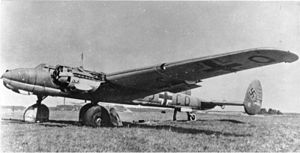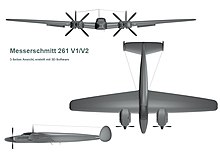Messerschmitt Me 261
| Messerschmitt Me 261 | |
|---|---|
 Messerschmitt Me 261 in Lechfeld 1945 |
|
| Type: | Reconnaissance plane |
| Design country: | |
| Manufacturer: | |
| First flight: |
December 23, 1940 |
| Number of pieces: |
3 |
The Messerschmitt Me 261 was a twin-engine German aircraft from the time of the Second World War . It didn't get beyond prototype status.
development
The Me 261 was originally designed in Messerschmitt's design offices for a record flight from Berlin to Tokyo. The Olympic flame should be transported. Thereafter, it was intended to be used as a reconnaissance aircraft and transporter . However, no particular urgency was ascribed to the project. Nevertheless, a prototype had its maiden flight on November 25, 1940 . The fact that the engine had been chosen for the new and untested Daimler-Benz DB 606 engine repeatedly prevented possible series production . After the destruction of the V3 prototype in July 1943, the project was discontinued without any results that could be used by the military. No Me 261 has ever been mass-produced.
The Messerschmitt 261 was planned as a self-supporting middle-decker . The drive for the prototypes V1 & V2 was provided by two Daimler-Benz-DB-606-A / B engines with a starting power of 2700 hp each. Typical for the appearance of the Me-261 prototypes were the disc stabilizer and the elongated shape with the wide wings. The goal of developing this long-haul aircraft in all-metal construction was a range of 11,000 kilometers and a speed of around 600 km / h.
Built planes
Me 261 V1
This first prototype had its maiden flight on December 23, 1940. Due to numerous problems in the development of a series predecessor, the aircraft could not be transferred to the Rechlin test center until October 2, 1941 . However, it was not yet operational, the tank and engine mount would have required major modifications.
Me 261 V2
The first flight of the second prototype took place on November 25, 1942, but further testing made little progress due to the lack of engines. At the end of 1942, testing this aircraft was not a matter of urgency for the Air Force High Command . Available resources were used for aircraft that were already manufactured. In 1945, the remains of this aircraft were captured by the Americans in Lechfeld .
Me 261 V3
The third machine had been modified so that the wings were enlarged. A workshop flight was carried out on this prototype on October 15, 1942. The V3 was the most tried and tested aircraft, and the DB-610 engines , which had been largely untested until then, were also used to test their durability. In July 1943 the V3 overturned on landing. It was not rebuilt.
Technical specifications
- Wingspan: 26.87 m
- Length: 16.675 m
- Height: 4.72 m
- Engine: V1 / V2: 2 × Daimler-Benz DB 606 A / B with 2700 hp take-off power
- Engine: V3: 2 × Daimler-Benz DB 610 A-1 / B-1 with 2900 hp takeoff power
- Max. Speed: V1 / V2: 585 km / h, V3: 620 km / h
- Range at a flight speed of 400 km / h: 11,000 km
literature
- Bill Gunston, Tony Wood: Hitler's Air Force. Salamander Books Ltd., London 1977.
Individual evidence
- ↑ AERO, issue 113, p. 3162
- ↑ Daimler Benz DB610. RAF Museum Cosford, accessed on February 11, 2014 (English): "This type of engine was fitted to the Heinkel Hel77A-5 / R2 Greif (Griffon) and the Messerschmitt 261 V3."


